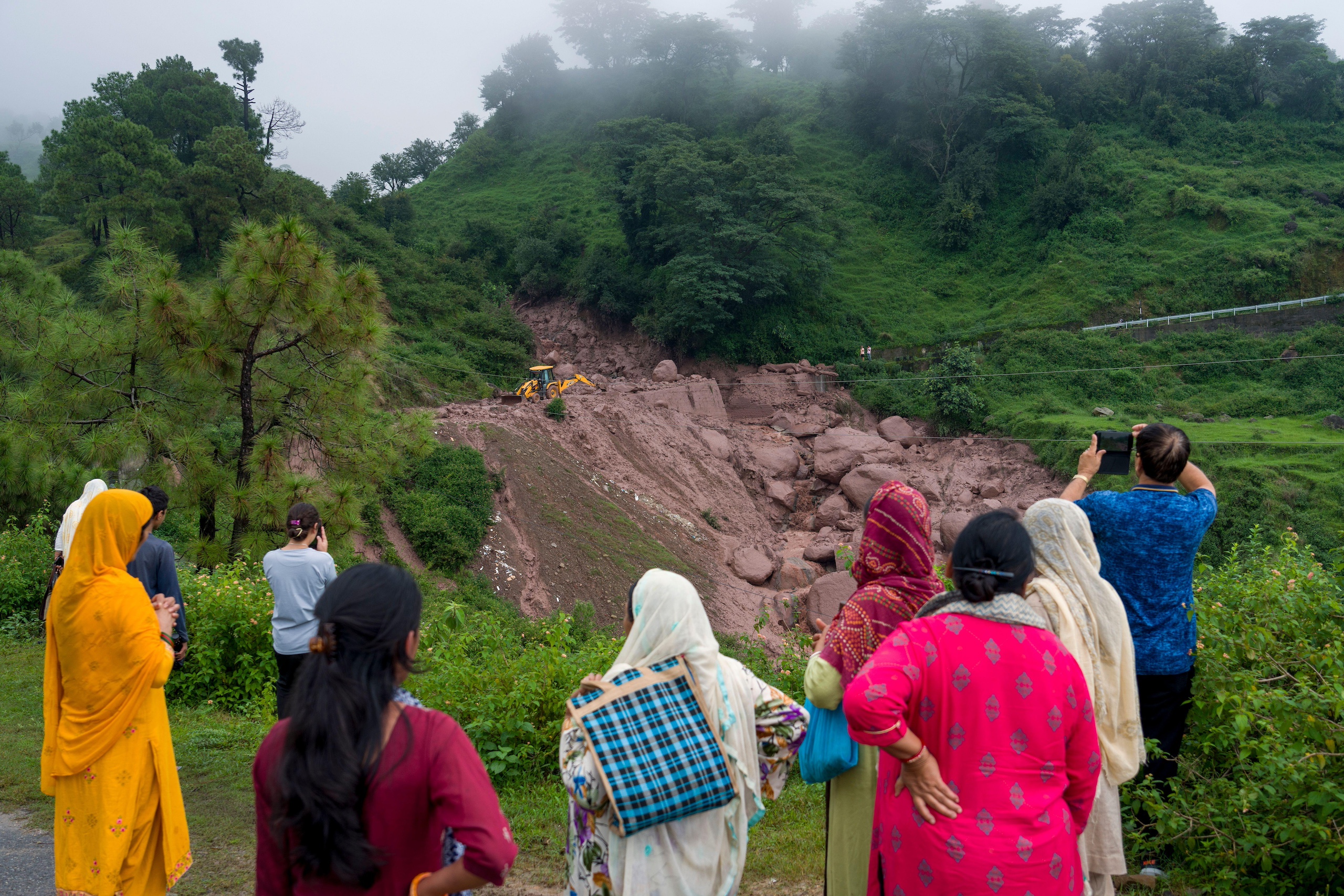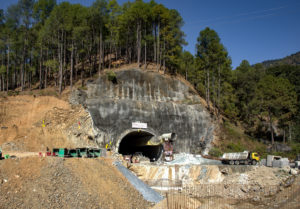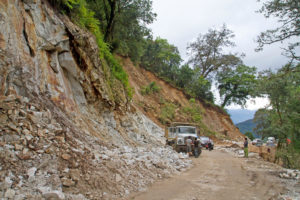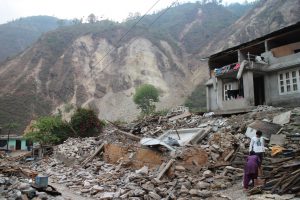On 14 August 2023, heavy rainfall in North India triggered flash floods and landslides, devastating the region. Kishori Lal, the sarpanch (head) of the Kothi Gehri village in the Himalayan state of Himachal Pradesh, recalls the events of that day: “Our link road connecting to the state highway and a few homes along that road were completely devastated,” he tells Dialogue Earth.
Torrential downpours in nearby Rewalsar, a picturesque lake town popular with tourists, led to several water bodies bursting their banks. The subsequent flooding and landslides wrecked homes in Lal’s village, necessitating the evacuation of hamlets and severing vital links to the outside world. With roads submerged, the ensuing closure of the Mandi-Rewalsar-Kalkhar Road and link roads left scores of tourists stranded and local communities isolated.
Amidst this chaos, the resilience of Nog, a village in Bilaspur district, stands out. While roads across the region, including those in and around Kothi Gehri, remained closed, the road leading to Nog was accessible in less than one week, according to officials.
The reason lies in an innovative approach: soil bioengineering.
Concrete retaining walls 10 feet high are the traditional go-to solution used to protect roads from hillside slopes. However, these structures leave exposed slopes vulnerable to erosion during intense rains, exacerbating the risk of landslides.
Sanjeev Dogra, vice president of the Nog panchayat, the local governing body, describes the threat landslides used to pose: “Our road used to suffer landslides every monsoon, which threatened villagers living nearby,” he says. Prior to the implementation of bioengineering measures, Nog’s road endured month-long closures on average during every monsoon season.
Innovating to strengthen soil
The turning point came in 2010, when bioengineering techniques were used to stabilise exposed slopes at two locations on the new link road to Nog, as part of the the Pradhan Mantri Gram Sadak Yojana (PMGSY), the Prime Minister’s Village Roads Scheme. Launched in 2000, the flagship government programme seeks to provide reliable all-weather connectivity to unconnected rural communities across the country.
Pawan Kumar Sharma, director of projects at Himachal Pradesh Road and Infrastructure Development Corporation Limited (HPRIDCL), explains the approach. “We treated the exposed surface of the potential landslide area near Nog by covering it with wire-mesh netting, planted shrubs and grasses within the grid,” says Sharma, who was an executive engineer with the Public Works Department in 2010 when that authority implemented the Nog project. “Where landslides were triggered by erosion from a local river, we planted brush hedges and hardwood cuttings to bind the soil.”
This green infrastructure took root within a single season, gradually fortifying the slopes, which were better able to withstand the effects of last year’s deluge.
Plants as a vital structural component of roads
Neha Vyas, a senior environmental specialist with the World Bank, defines bioengineering as a subset of green infrastructure and emphasises its role in mitigating environmental hazards by using vegetation to enhance slope stability.
This ecological engineering technique involves the strategic planting of vegetation and the incorporation of other organic materials to stabilise soil and enhance ecosystem resilience. By harnessing the natural properties of plants and their root systems, soil bioengineering can offer a sustainable and cost-effective approach to mitigate environmental hazards and promote landscape restoration. This method is particularly effective in fragile ecosystems and areas prone to natural disasters such as landslides and floods.
In Himachal Pradesh, soil bioengineering to stabilise slopes alongside roads has “involved the use of vegetation, both living and dead plants, such as bamboo, in conjunction with simple civil engineering structural elements such as catch drains, gabion walls and others,” explains Vyas.
The Nog bioengineering initiative was the first of over 250 mountainous road stretches treated with the World Bank’s assistance. Dalip Chauhan, president of the Jubbal panchayat, attests to its efficacy, citing reduced damage along the state highway #10 during last August’s catastrophic floods.
By absorbing much more water, bioengineered slopes can reduce erosion, water logging and damageNeha Vyas, a World Bank environmental specialist
“If soil bioengineering is designed after due investigation and analysis, and monitored during execution, it effectively controls erosion along roadways, which is crucial to maintain the integrity of the road section and can even help during the heavy rains that are becoming more commonplace due to climate change,” says Vyas.
“Soil bioengineering can also improve the stability of slopes along roads, thereby reducing the risk of landslides, increasing safety for people and protecting assets,” she adds. “By absorbing much more water, bioengineered slopes can reduce the runoff and the ensuing erosion, water logging and damage.”
Moreover, Vyas asserts that selecting appropriate vegetation species can lead to carbon dioxide absorption, habitat creation for wildlife, increased ecosystem resilience and additional livelihood sources for local communities.
Harvesting grass planted by the roadside has saved Sonali, a 38-year-old cattle-rearing resident of Nog, many visits to the forest where the species is usually found. “Planting vegetation that can be used as fodder by the road to help protect it is doubly useful for us,” she tells Dialogue Earth. “I source about half of the fodder I need from the roadside. I wish such species were planted alongside all the roads in the area.”
Implementation is key
Soil bioengineering can be a useful tool in combatting erosion and stabilising slopes, but its effectiveness ultimately depends on careful planning, proper implementation and ongoing maintenance.
While the National Highways Authority of India (NHAI) is responsible for the development, maintenance and management of national highways across India, state highways and link roads are the responsibility of the Public Works’ Department (PWD).
Experts have criticised the “unscientific” practices of cutting into hills for national highway widening projects in Himachal Pradesh, citing them as a significant factor contributing to some of last year’s most severe landslides. Sharma emphasises how road excavations in hill topographies render the ground more prone to landslides.
“Cutting into a hill opens a window for soil erosion,” says Sharma.
This underscores the heightened importance of bioengineering as a vital component of both the ongoing Himachal Pradesh Roads Transformation Project and the Green National Highways Corridor Project.
However, problems arise when bioengineering specifications fall short or are inadequately implemented, as seen in the Parwanoo-Solan stretch of national highway #5.
Despite recognising the need for robust vegetation growth, contractors often prioritise cost over effectiveness, resulting in incomplete implementation. One NHAI senior official told Dialogue Earth that on one pilot initiative around Parwanoo, grassing was achieved in only 40-50% of the stretch.
To maximise efficacy, experts advocate for a multi-pronged approach that ensures vegetation growth, with Vyas pointing out that “horticultural principles must be used along with the application of engineering design principles to build structures that will protect the plant communities as they grow to maturity and function as they would in their natural settings.”
Himachal Pradesh’s bioengineering specifications require contractors to appoint supervisors to watch over and maintain sites, ensuring that the vegetation and other bioengineering elements grow and develop as desired.
Sharma highlights the importance of selecting low-maintenance indigenous plants “with aesthetic value, medicinal value, commercial value and grasses that can be used as forage for cattle.”
Despite this, reports indicate that bioengineering efforts on the Parwanoo-Solan stretch were limited in scope, underscoring the need for comprehensive implementation.
In response to last year’s losses, in February 2024, the highway authority initiated additional tenders for soil stabilisation worth USD 24.14 million (INR 200 crore), recognising the urgency of investing in bioengineering amidst climate change-induced rainfall unpredictability.
Vyas describes investments in bioengineering as “investments in safety and sustainability, which are much more cost-effective and visually more appealing than hardcore engineering and less environment-friendly structures.”
As Himachal Pradesh prepares for future climatic uncertainties, soil bioengineering emerges as a potential innovative lifeline to help protect lives and livelihoods.
“While it is impossible to defeat nature, surely we can use bioengineering and allied techniques to make roads that are as climate-resilient as possible,” says Sharma.







![vehicles stranded due to a landslide atop a road being widened under the Char Dham Project [Image by Hemant Dhyani]](https://dialogue.earth/content/uploads/2020/08/CDP-Landslide-Hemant-Dhyani-300x201.jpg)



